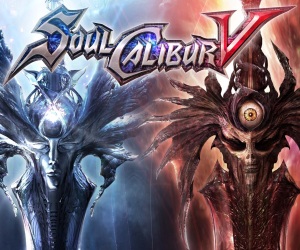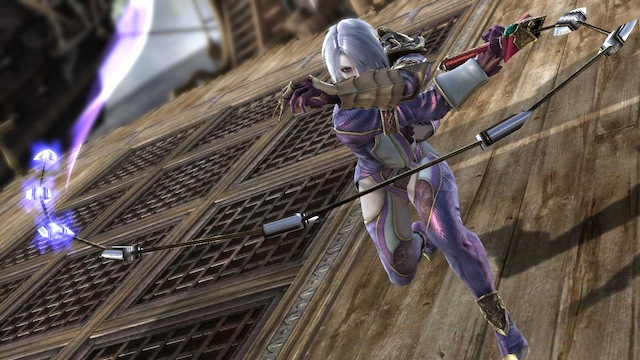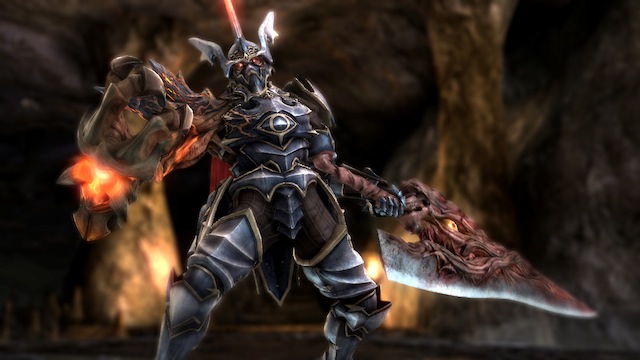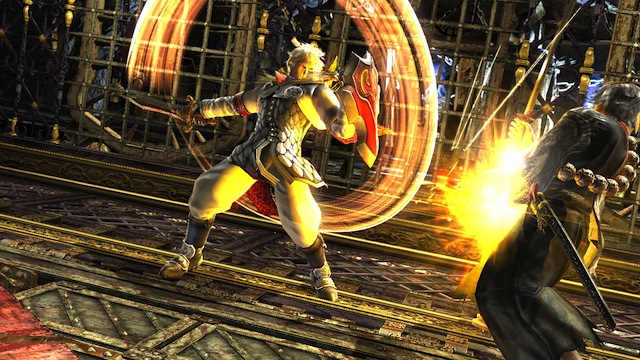Soul Calibur V Review
 Game: Soul Calibur V
Game: Soul Calibur V
Developer: Project Soul
Publisher: Namco Bandai
Available on: Xbox 360 and PlayStation 3 (Reviewed on Xbox 360)
Namco are set to make a big splash in the fighting game market in 2012, whether teaming up with one-time rivals Capcom for the highly anticipated Street Fighter X Tekken inter-universe dust up, or striking out on their own with a new handheld version of Tekken, or the forthcoming (and very promising, if you check our look at the mouth-wateringly frustrating Hybrid) sequel to long standing favourite Tekken Tag Tournament. But while Kazuya and Jin are all set to shine once again, people forget that Namco Bandai have another brawling franchise that, after a couple of horrible misfiring sequels, is definitely due for a makeover and relaunch.
Namco Bandai have had nearly four years to work on a sequel to the last Soul Calibur game and developers now have the clout to really squeeze some juice out of the consoles at their disposal. Old school fighting favourites have had some stunning reboots in the last few years, and the genre is riding as high as it has ever been. The question is, can Soul Calibur once again take a seat at the top table with the big boys? Or is this a disappointment as huge as Voldo’s codpiece?

STORY: Unlike previous games in the series, which have focused primarily on the Siegfried and Nightmare characters, and the ongoing saga of the cursed Soul Edge blade, this instalment centres on two new characters, the brother and sister combo of Patroklos and Pyrrha, who happen to be the offspring of Soul Calibur mainstay Sophitia, and her old man Rothion. To begin with, the siblings are separated, and entering the sizeable Story mode you take the reigns of the pair at different intervals as they attempt a reunion, and to seek out the reasons behind their mother’s untimely demise at the hands of the creepy Malfested, people who have been altered to a demonic state by the damned Soul Edge weapon. The lengthy story introduces several new characters on either side of the Malfested fence, and features a number of surprising twists and turns along the way, told by a plethora of beautiful hand-drawn static illustrations and excellent cut-scenes. The historical, weapons based drama that has become the series’ trademark is in full effect here, and while at times the script is a bit of a clunker, you don’t enter into “The Stage of History” expecting Oscar winning scriptwriting. This is stirring stuff indeed.
GRAPHICS: Soul Calibur IV was no slouch in the graphical stakes, and the sequel builds upon the excellent visuals of its predecessor and looks drop-dead gorgeous, a treat for the eyes. The characters are huge and incredibly detailed. The well-rounded new additions to the roster, including Assassins Creed latin stealth-smith Ezio Auditore, fit right in to the mix, alongside the best representations yet seen of old favourites. There are a huge array of new arenas, some of which feature different fighting layers (a la Dead or Alive), as you crash through the floor between rounds and drop down to a different area below to carry on the brawl. Some of the backdrops need to be seen to be believed, I was particularly enamoured with the pirate ship stage, where you battle on the high seas surrounded by a veritable armada of ships, all firing cannons and whatnot as the waves jostle your floating platform all over the place.
SOUND: Grand, sweeping orchestral fare is the order of the day once again in the soundtrack stakes. Even when Soul Calibur hit its Yoda-starring canonical nadir, you could always expect Namco Bandai to deliver with their musical compositions, and they have done it again, with a suitably bracing selection of dramatic tunes. The sound effects are as sword-clinkingly excellent as ever, and all of the characters and cut-scenes are fully voice-acted. It is in this department that I will deliver perhaps my only criticism of an otherwise sterling, rock-solid game. The voice acting and characterisation is, at times, downright awful. Maybe it is just me, but I found that the protagonists that you start out with are among the most irritating creations committed to fighting folklore. Patroklos, with his feathery blond hair-do and holy crusader chic, looks like a suitably heroic dude, but when he opens his mouth, you feel the urge to punch it shut. He is an unlikeable, cocky, emo-tinged creation, who bangs on about “justice” all the time, in a whining American accent. Pyrrha is even worse. In the story, she is fighting for her life, against her will, against everything she believes in. Fair enough, the poor lass has got a lot on her plate, I understand that. But this reluctance to fight manifests itself with a grating, screeching vocal performance that lets us know how unhappy she is with virtually every strike of her sword. “I can’t…please, stop!” she wails, as you batter someone with her Critical Edge mega-attack.

GAMEPLAY: Your fighting games live or die by their combat system, those are the rules, and why we are playing Soul Calibur V and not Battle Arena Toshinden 8. Soul Calibur, as a result of the unique 8-way trickery and considered, balanced weapon-based attack, has always been reliably sound in this department. With a number of new tweaks and additions, this sixth version is as playable a fighter you can get your hands on, easy to learn, and difficult, but rewarding, to master.
First up, the omissions and their replacements. The finishing moves from the last instalment have been removed, as has armour destruction meter (although you can still smash your opponent into an un-armoured state). The Soul Gauge has been replaced with a meter more akin to those seen in other contemporary fighters, and you can charge it up during combat. The meter stocks are then used, much like Street Fighter IV, to execute the more powerful Brave Edge or devastatingly powerful Critical Edge strikes, which mimic the Super and Ultra combo attacks from Capcom’s classic. A segment of meter can also be used to perform a Guard Impact manoeuvre, which can repel even the meatiest of attacks, leaving your foe wide open for a beatdown. A simplified parrying system, called Just Guard, is similar to the one seen in SNK’s gold-standard Garou: Mark Of The Wolves and requires a perfectly timed use of the block button to coincide with your opponents’ attack. The good thing here is that unlike the Guard Impact, failure to perfectly time a Just Guard will not put you at any disadvantage, so long as you still manage to execute the block before a huge sword or suchlike finds itself in your face.
All of these wondrous techniques are accessed using a four-button system, with each of the face buttons on your control pad (or buttons on your stick, Hori fans) representing either vertical slash, horizontal slash, kick, and block.
Consideration needs to be given this time around to the stages themselves. As mentioned, some are multi-layered. Others are claustrophobic and enclosed, suiting brutal wall-slamming manoeuvres. There are Ring Outs, with arenas like the aforementioned pirate flotilla lending themselves well to a Virtua Fighter-style ejection from proceedings.

LONGEVITY: With plenty of modes to play around with, the sixth Soul instalment is going to keep you interested for a long while. There are your standard Arcade, VS and Training modes, as well as a lengthy story mode which, like Mortal Kombat, puts you in control of a number of different characters as the tale unfolds, with different fighting conditions applied for each battle. If you can stomach listening to Pyrrha bang on about her fighting issues, and don’t mind some of the worst acting in video game history, then Story Mode will keep you enthralled to the Soul Calibur bonkers-verse. There is a substantial character creation mode, with new bits and pieces unlockable throughout other parts of the game. We have seen a decent edit mode before in the series, but never before with this much depth.
Quick Battle allows you to take on an array of crazy customised characters of varying difficulty, with AI designed to mimic actual real life players. In this mode you can unlock player titles and icons to customise your in-game gamercard. There is also an unlockable boss rush mode, called Legendary Souls, and the option to simply watch two CPU controlled fighters get it on in Theatre Mode.
Factor into the equation that there are over 20 arenas and 25+ characters, some of which will require meeting conditions to unlock, a wide array of achievements to get your hands on, and Namco Bandai promising a wealth of downloadable content and an update to implement online battles upon release, and chances are you will still be playing Soul Calibur V long into 2012.

VERDICT: This is as good as it gets for Soul groupies, the best realisation of Project Soul’s 16 year old creation, and something Director Daishi Odashima can be truly proud of. This is going to be a huge year for fighting games, with the aforementioned Capcom/Namco crossover, Skullgirls, a new Blazblue, and some promising looking Vita and 3DS renditions of existing games on the horizon. As it stands this is the best one on one release of the year so far, and something that stands Namco Bandai in good stead for their other pending efforts due to surface over the course of the year. Packed with features, this will hold your interest for many moons to come, and I personally cannot wait to see what we have in store in terms of online play, something I anticipate with baited breath, such is my desire to tan someone’s hide across my WiFi connection, preferably Pyrrha, using my character of choice Cervantes, who manages to combine some of my favourite things (piracy, red-blooded Iberian machismo, guns and swords) for an epic win. Welcome to the stage of history? Welcome back, Soul Calibur.





